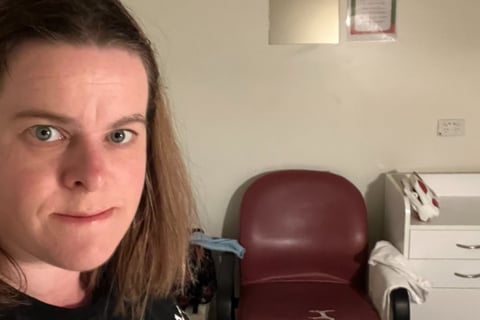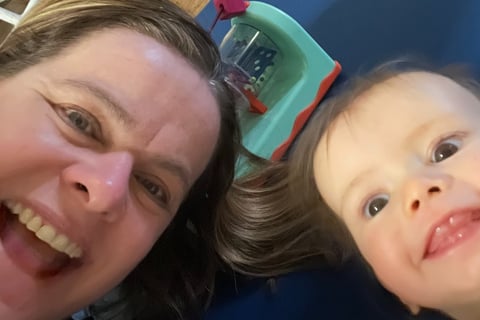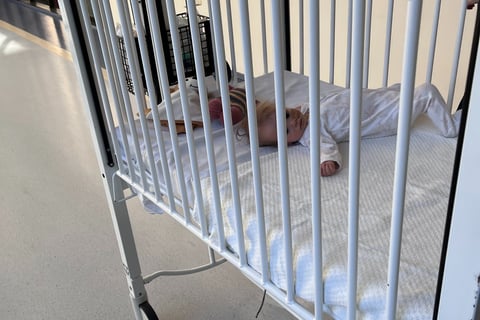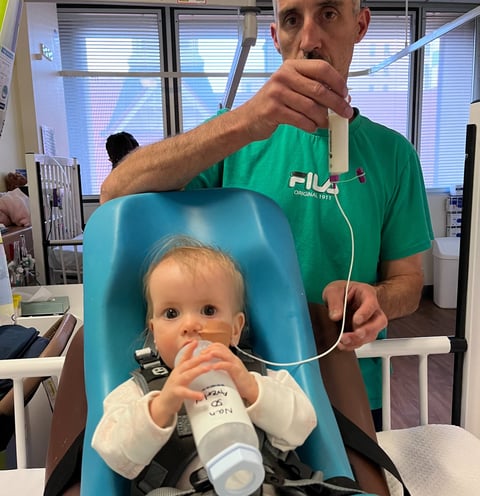Thriving Slowly: The beginning of Tube Feeding
I share our family’s experience with my daughter Averley's hospital admission and the journey of transitioning to nasogastric (NG) tube feeding. From preparing for the unexpected hospital stay to understanding various tests like genetic microarray, bone X-rays, and the sweat test, I cover what families can expect when navigating complex feeding issues. I also offer practical tips on how to manage hospital stays, including feeding plans, hospital resources, and staying organized amidst medical uncertainties. Whether you're a parent facing a similar situation or a caregiver wanting more insight into feeding interventions, this post offers support, advice, and a warm invitation to reach out if you need help navigating the system.
5/8/20245 min read
Our Journey to Tube Feeding: What to Expect
After several attempts with different feeding plans, at 10 months old, Averley was admitted to the hospital with the intention of getting a nasogastric (NG) tube. We didn’t know what to expect. Our paediatrician had mentioned earlier that we might need to explore tube feeding, but it wasn’t something I had fully comprehended until that moment.
On the day it was decided that she needed additional feeding support, I remember vividly taking her to her scheduled appointment. The paediatrician advised me of the situation: her weight and growth were still concerning, and more needed to be done.* He called the head of paediatric medicine at the public children's hospital, but just as they were paged, my paediatrician was called away to attend a birth. So, there I was, sitting in the office with my baby, holding the news of a big change.
The Waiting Game
All sorts of thoughts raced through my mind: How will we manage with the other children at home? How long will we stay in the hospital? Can I stay with her? Is it surgical? What do we need to prepare? I focused on the practical aspects because that’s what I could control.
When the paediatrician returned, he informed me that there would be a short wait for a bed, and she would be admitted soon. Phew! I didn’t have to rush into organizing everything that day. It took about two weeks to get a hospital bed, and we were told we’d be there for at least five days, though we wouldn’t know the admission date until the day of. Living an hour and a half away from the hospital, this added another layer of stress. Fortunately, everything went smoothly on the day she was admitted, and I was able to stay with her in a small room just outside the ward.
A Hospital Stay Unlike Any Other
Averley was in a shared room with two other children, both very ill with oxygen tubes and feeding tubes already in place. I felt nervous and unsure about what lay ahead. Watching the nurses care for these children while their parents weren’t there stirred something deep within me. I wondered if this was what the future looked like for us.
As the days passed, we watched other families come and go. Children who looked so unwell one moment were discharged the next, while new patients took their place. I felt a wave of guilt—my child wasn’t sick like them. Why were we still there? But Averley was there because she needed the support, even if her challenges were different.
The Tests and the Tube
During our stay, Averley underwent a series of tests to help rule out other underlying conditions. Blood tests, urine tests, stool tests, a full-body X-ray to check for asymmetry and bone age, and a sweat test to rule out cystic fibrosis. (For more info on cystic fibrosis testing, visit this link.) We also underwent a MicroArray, a genetic test that looks for deletions or additions in chromosomes.
On day three, the NG tube was inserted. While the process wasn’t painful, it was uncomfortable. A small tube is fed through the nose and down to the stomach, allowing food to bypass potential feeding issues. Despite the tube, you can still breastfeed and offer solids if there are no issues with swallowing or aspiration.
Averley was already eating solids (quite a lot!), so we were “topping up” with bolus feeds—using a 20 ml syringe to gravity-feed formula through the tube. It was an intensive process, but we were determined to make it work.
Adjusting to Tube Feeding
Getting used to the NG tube wasn’t easy. Averley, like so many other children, yanked it out several times in the first few days. They come out so quickly—literally in less than a second. Luckily, they didn’t use a bridle (a head strap to hold the tube in place) at this stage, and Averley gradually began adjusting to the tube.
Finally, the day came when we were to be discharged. We had been trained to manage her feeds, but the transition to this new normal was daunting. Were we really ready?
Tests They Took and Why
While in the hospital, several tests were conducted. Some were routine, while others were more specific:
Blood tests – Used to rule out various conditions.
Urine tests – To check for infections or metabolic issues.
Stool tests – To investigate digestion problems.
Bone X-ray (Full body) – This test may or may not be done depending on the child’s age. In Averley’s case, it helped assess her bone age and checked for any asymmetry.
Sweat test – A painless test used to diagnose cystic fibrosis by measuring chloride levels in the sweat. It takes about an hour to complete.
MicroArray – A genetic test to check for deletions or additions in chromosomes.
Support You May Encounter
Throughout our hospital stay, we were visited by numerous health professionals. It’s helpful to keep records of your feeding journey and any previous tests, as you’ll be asked the same questions many times. Here’s a list of professionals we encountered:
Speech pathology
Occupational therapy
Dietitian
Gastroenterology
Chaplain
General medical team
Tips for Hospital Stays
Ask about accommodations – If you're breastfeeding or staying overnight, ask if there's a place to stay close by, such as a room on the ward.
Communication is key – Make sure to understand how to communicate with the nursing staff. For instance, I didn’t realize I needed to write Averley’s feeding schedule on the board, which made it hard to ask for food initially.
Avoid weekend discharges – Try not to get discharged on a Friday afternoon or weekend, as fewer staff are available, which can make things more complicated if follow-up care is needed.
Comfort is crucial – Slip-on shoes and slippers are a must. You’ll be sitting for long periods but want to be able to move quickly when needed.
Bring food or ask about a fridge – Hospital food can be expensive, so check if there’s a parent room with a fridge to store your meals.
Get fresh air – If you can, take your child outside for a break. It helped keep us both a little sane during our stay.
Note: Paediatric Care in Australia
In Australia, seeing a paediatrician isn’t always the norm. Usually, you’d see a General Practitioner (GP) first and get a referral. We had private health care and were assigned a private paediatrician at birth. Ironically, in many cases, it was easier to get an appointment with the paediatrician than with our GP, given the shortage of GPs, especially in regional areas like where we live.
Also of note, this is from our experience only.






the little room that I stayed in. I would sleep and the nurses would come and get me when averley needed care. Wasn't great but it was better than the chair next to her bed. recommend bringing your own Blanky


Our first Bolus Feed.
Getting transported around the hospital for different tests
Playing with the toys on the ward.
